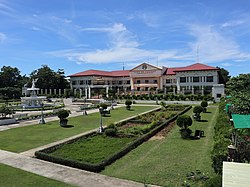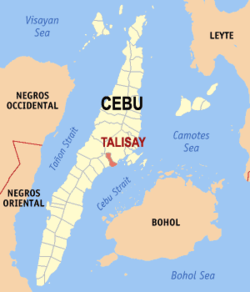Talisay | |
|---|---|
| City of Talisay | |
 Talisay City Hall and Plaza | |
| Etymology: Magtalisay trees | |
| Nicknames: | |
| Anthem: Abante Talisay | |
 Map of Cebu with Talisay highlighted | |
Location within the Philippines | |
| Coordinates: 10°15′N123°50′E / 10.25°N 123.83°E | |
| Country | Philippines |
| Region | Central Visayas |
| Province | Cebu |
| District | 1st district |
| Founded | 1648 |
| Chartered | 1849 |
| Cityhood | December 30, 2000 |
| Barangays | 22 (see Barangays) |
| Government | |
| • Type | Sangguniang Panlungsod |
| • Mayor | Gerald Anthony V. Gullas Jr. (NP) |
| • Vice Mayor | Richard Francis F. Aznar (NP) |
| • Representative | Rhea Mae A. Gullas (NP) |
| • City Council | Members |
| • Electorate | 155,392 voters (2025) |
| Area | |
• Total | 39.87 km2 (15.39 sq mi) |
| Elevation | 108 m (354 ft) |
| Highest elevation | 915 m (3,002 ft) |
| Lowest elevation | 0 m (0 ft) |
| Population (2024 census) [5] | |
• Total | 263,832 |
| • Density | 6,617/km2 (17,140/sq mi) |
| • Households | 63,066 |
| Economy | |
| • Income class | 1st city income class |
| • Poverty incidence | 19.17 |
| • Revenue | ₱ 1,631 million (2022) |
| • Assets | ₱ 2,678 million (2022) |
| • Expenditure | ₱ 1,625 million (2022) |
| • Liabilities | ₱ 738.3 million (2022) |
| Service provider | |
| • Electricity | Visayan Electric Company (VECO) |
| • Water | Metropolitan Cebu Water District (MCWD) |
| Time zone | UTC+8 (PST) |
| ZIP code | 6045 |
| PSGC | |
| IDD : area code | +63 (0)32 |
| Native languages | Cebuano Tagalog |
| Major religions | Roman Catholicism |
| Feast Day | October 15 |
| Patron saint | Saint Teresa of Avila |
Talisay, officially the City of Talisay (Cebuano : Dakbayan sa Talisay; Filipino : Lungsod ng Talisay), is a component city in the province of Cebu, Philippines. According to the 2024 census, it has a population of 263,832 people, making it the most populous component city in Visayas. [7] The city is applying for a Highly Urbanized City (HUC) status.
Contents
- History
- Cityhood
- Geography
- Barangays
- Climate
- Demographics
- Religion
- Economy
- Culture
- Transport
- Education
- References
- Sources
- External links
The city's name is taken from the talisay tree which is abundant in the area.






